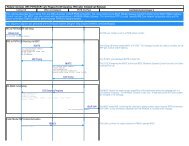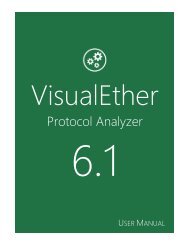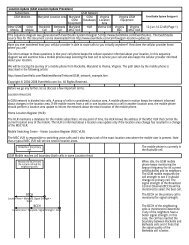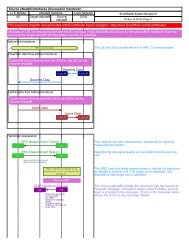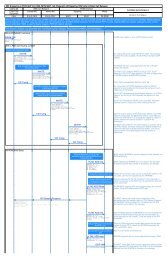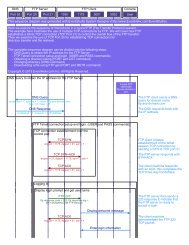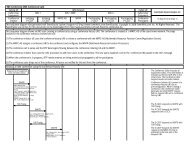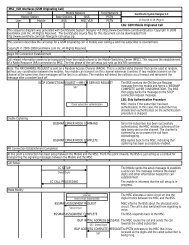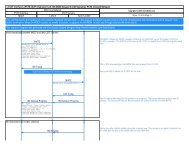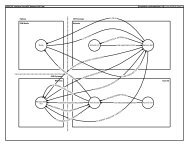SDP Codec Selection and QoS Signaling in an ... - EventHelix.com
SDP Codec Selection and QoS Signaling in an ... - EventHelix.com
SDP Codec Selection and QoS Signaling in an ... - EventHelix.com
Create successful ePaper yourself
Turn your PDF publications into a flip-book with our unique Google optimized e-Paper software.
<strong>SDP</strong> Use <strong>in</strong> <strong>an</strong> IMS-to-IMS Call (<strong>SDP</strong> <strong>Codec</strong> <strong>Selection</strong> <strong><strong>an</strong>d</strong> <strong>QoS</strong> <strong>Signal<strong>in</strong>g</strong>)<br />
Call<strong>in</strong>g UE Core Network Called UE<br />
EventStudio System Designer 4.0<br />
Caller User GGSN Called User<br />
Equipment<br />
Equipment<br />
07-Dec-07 22:30 (Page 2)<br />
Caller GGSN Called<br />
Activate PDP Context Accept The called PDP context activation has been <strong>com</strong>pleted. At this po<strong>in</strong>t, the caller <strong><strong>an</strong>d</strong> the<br />
called PDP contexts are both active. The <strong>QoS</strong> for the call c<strong>an</strong> now be met.<br />
Activate PDP Context Accept<br />
The caller PDP context activation has been <strong>com</strong>pleted.<br />
UPDATE<br />
v=0,<br />
o=- IN IPV6 ,<br />
c=IN IPV6 ,<br />
s=-,<br />
t= 0,<br />
m=audio RTP/AVP 97,<br />
a=rtpmap:97 AMR,<br />
a=curr:qos local sendrecv,<br />
a=curr:qos remote none,<br />
a=des:qos m<strong><strong>an</strong>d</strong>atory local sendrecv,<br />
a=des:qos m<strong><strong>an</strong>d</strong>atory remote sendrecv<br />
200 OK<br />
v=0,<br />
o=- IN IPV6 ,<br />
c=IN IPV6 ,<br />
s=-,<br />
t= 0,<br />
m=audio RTP/AVP 97,<br />
a=rtpmap:97 AMR,<br />
a=curr:qos local sendrecv,<br />
a=curr:qos remote sendrecv,<br />
a=des:qos m<strong><strong>an</strong>d</strong>atory local sendrecv,<br />
a=des:qos m<strong><strong>an</strong>d</strong>atory remote sendrecv<br />
S<strong>in</strong>ce the caller PDP context has been activated, notify the called end that the caller c<strong>an</strong><br />
now meet the quality of service <strong>in</strong> the send <strong><strong>an</strong>d</strong> receive direction. The "a=curr:qos local<br />
sendrecv" signals that the caller (local) PDP context has been established. Note that the<br />
UPDATE is be<strong>in</strong>g sent <strong>in</strong> response to the QOS confirmation request received <strong>in</strong> "183<br />
Session Progress" message from the caller.<br />
The caller replies back to the called user. Note that the "a=cur" l<strong>in</strong>e for the called (local) has<br />
been updated to <strong>in</strong>dicate that called end <strong>QoS</strong> is also met.<br />
R<strong>in</strong>g<strong>in</strong>g Now all the resources for the call are <strong>in</strong> place. R<strong>in</strong>g the called subscriber to notify the user<br />
about the <strong>in</strong><strong>com</strong><strong>in</strong>g call.<br />
180 R<strong>in</strong>g<strong>in</strong>g Inform the caller that the called subscriber is be<strong>in</strong>g rung. This serves as <strong>an</strong> implicit<br />
<strong>in</strong>dication to the caller that the <strong>QoS</strong> at the called side has also been met.<br />
PRACK<br />
The caller acknowledges the r<strong>in</strong>g<strong>in</strong>g message.<br />
200 OK The called subscriber acknowledges the PRACK.<br />
Answer The called subscriber <strong>an</strong>swers the call.<br />
200 OK Notify the caller that that the call has been <strong>an</strong>swered.<br />
ACK<br />
Conversation on a direct RTP/RTCP connection between the caller <strong><strong>an</strong>d</strong><br />
called subscriber SIP phones.<br />
The caller acknowledges the "200 OK" message. The call is now ready to enter conversation<br />
mode.



